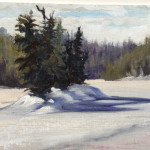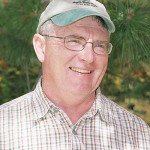Odin Jorgenson has spent the entire year preparing for winter. Now he and his dog team are ready for the racing season.
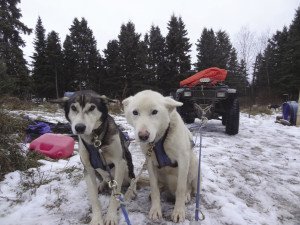
No stranger to competition, Jorgenson has mushing in his blood. His father, Arleigh Jorgenson, was one of the Cook County mushers that organized the original Gunflint Mail Run Sled Dog Race, which later grew into the longest sled dog race in the lower 48; the John Beargrease Sled Dog Marathon.
The Gunflint Mail Run as been resurrected in recent years and will be held Jan. 9-10 on the Gunflint Trail. Jorgenson is competing in the race.
Though the elder Jorgenson has essentially retired from mushing, Odin has been training for both races, despite having two toddlers running around the house. He averages 15 training runs a month, using an ATV instead of a sled before the snow falls. He describes December, specifically the time between Christmas and New Year’s, as a crucial time for getting the dogs ready for the main event.
“To be fair to the dogs, mushers need to show them what will be expected from both a physical and mental perspective,” explained Jorgenson.
In an effort to mimic those race realities for both himself and his dogs, Jorgenson simulates the camping, or layover, aspect of the competition on multiple occasions prior to the race. Official rules of the Beargrease require four hour layovers in between segments of racing. Jorgenson began to integrate this format into his mid-December training with two 40-mile runs, separated by a four-hour break.
Stepping up the pace immediately after Christmas, Jorgenson includes three to four 60-mile runs as well as camping training. Backing off to 40-mile runs leads him right in to the first Cook County race of the year, the Gunflint Mail Run.
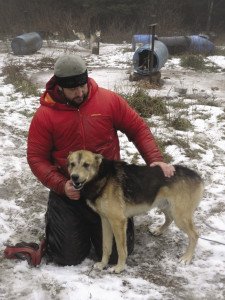
The precursor to the Beargrease Sled Dog Marathon, racers in the Mail Run can choose from two classes this year: a 12-dog, 110-mile race, or a new 8-dog, 70-mile race. Jorgenson, the 2012 winner of the Gunflint Mail Run, plans to race again this year in the traditional longer division.
In each of the classes, the race consists of two equidistant legs, separated by a mandatory layover. The race can accommodate up to 30 racers and will start, layover, and finish at Trail Center Lodge, approximately 30 miles up the Gunflint Trail. Race organizers hope that the addition of a class will help to make the race more inclusive.
“The shorter, faster eight-dog race will add a whole new dimension to the Gunflint Mail Run,” explained race co-director Jack Stone, owner of Stone Harbor Wilderness Supply. “This shorter race also gives newer mushers or mushers with smaller kennels the opportunity to compete in this race.”
Following the Mail Run, Jorgenson’s training will slow and the Beargrease Marathon race day checklist will begin to take priority. His days will be filled with tending to his own aches and pains, as well as those of his dogs. As can be expected, their feet are of utmost importance.
“I make sure to cover all the little things like clipping toe nails, inspecting feet daily (maybe twice daily) and applying ointment or liniment if needed,” says Jorgenson. “I also make sure I am going over all dogs with massage to make sure I know if there are little aches and pains I have missed in the whirlwind of the heavier training prior.”
Keeping his championship dogs healthy is something that he does not take lightly, especially because many of these dogs come from a very specific bloodline. Though some of them are mixed with a type of hound, all have Alaskan husky in them. According to Jorgenson, there is quite a bit of commonality among the top racing dogs, mainly because they have proven themselves to be the best.
“There was a dog named Lingo who belonged to a famous native musher named George Attla. He is behind many of the dogs I have right now. If you start tracing the pedigrees, many of the best dogs have commonality in their background.”
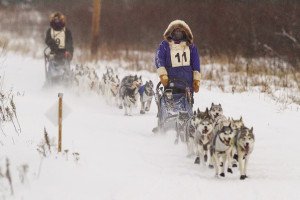
Cleaning harnesses and collars, double-checking the sled’s mechanics and organizing all the equipment keeps Jorgenson busy right up until the Beargrease.
There are four different race distances for competitors: marathon, mid-distance, junior and rec race. The marathon course is just under 400 miles long and sees mushers complete an out-and-back course on the North Shore of Lake Superior. The trail start and end are occasionally altered due to fluctuating levels of snow. The topography of the course is similar to the Superior Hiking Trail: rugged hills.
Championship teams have to be ready for an event with strict and thorough rules. The racers must start with a minimum of 10 dogs and must run at least six dogs in the harness at all times. There are two mandatory, predetermined four-hour layover stops for all mushers. The additional 20 hours of required layover time are at the drivers’ discretion. The stakes are high; mushers who compete at a superior level and follow the rules can qualify for the famed Iditarod in Alaska.
Spectators can watch the teams in the 32nd annual Beargrease at one of the many checkpoints along the course. The marathon and mid-distance races begin at 3 p.m. on Sunday, Jan. 31 and will conclude the morning of Wednesday, Feb. 3. In an effort to further honor the contributions of John Beargrease, all mushers are sworn in as official U.S. mail carriers prior to the race and carry small amounts of mail on the trail.
7 a.m. Blessing of teams
8 a.m. Race start
Mid-afternoon Layover
Early evening Restarts
Late evening
/early morning Finish
10 a.m. Awards breakfast



